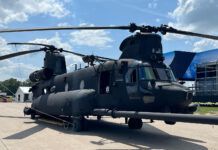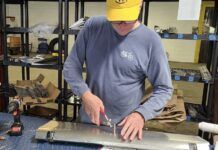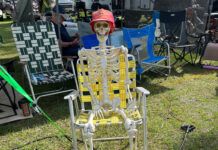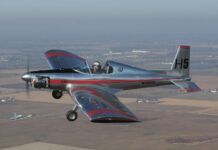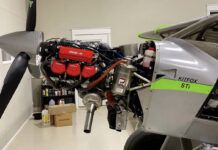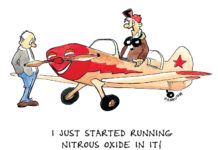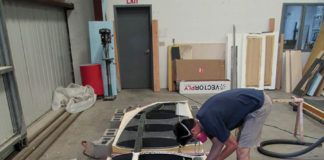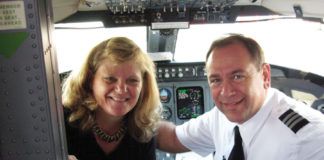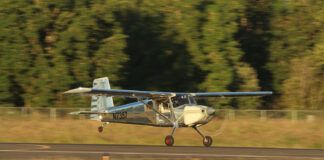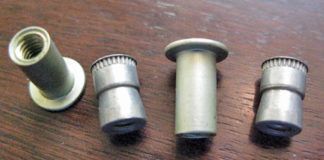It was just another normal spring afternoon at Liberty Landing International Airport, in Liberty, Missouri. The stalwart studmuffins of The Dawn Patrol were waiting for the bump dummy (aka my wife, Sharon, in her Kolb Twinstar, MK II) to land and give us the latest BDPIREP (bump dummy pilot report). She’d already been up twice and both times gave us the thumbs down when she landed. We had high hopes that this time we’d get the much anticipated thumbs up, so we could unleash the canvas falcons of The Dawn Patrol and start our afternoon patrols of the trenches and shell holes surrounding the field.
We all watched carefully as she greased her Kolb in, hoping for a bounce so we could give her some grief about her landing. She taxied up to us with a disgusted look on her face, shut off the mighty Valley Engineering Big Bad Twin four-stroke engine and gave us an emphatic thumbs down. So we all settled back in our lawn chairs, popped the top on another frosty can of hearty Diet Dr. Thunder, and went back to solving the problems of the world.
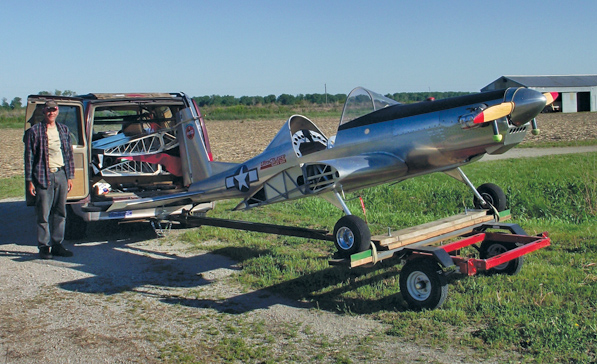
Who needs a hangar? Dennis Brooks stands with his Hummel UltraCruiser ready to either go home or put it together to fly. If you don’t have a van or truck for the wings, with a little bit of work, the trailer can be modified to carry them. In fact, a covered trailer can be built for much less than the cost of renting a hangar for a year.
Liberty Landing International
Missouri 210, the road running past the airport, is pretty much an abandoned highway now. The new highway Route 210 runs about a quarter-mile north of the airport. So old 210, where we are, has become a place where bicycle racers and others practice without traffic. In fact, more trains pass by on the tracks on the other side of the road than cars. Farm equipment occasionally thunders down the old highway with the drivers always giving us a friendly wave.
The only excitement we have is when some future organ donor in a high-performance “crotch rocket” motorcycle screams by at over 100 mph on the one-mile straight shot that passes the field. Usually, we never even see them flash by.
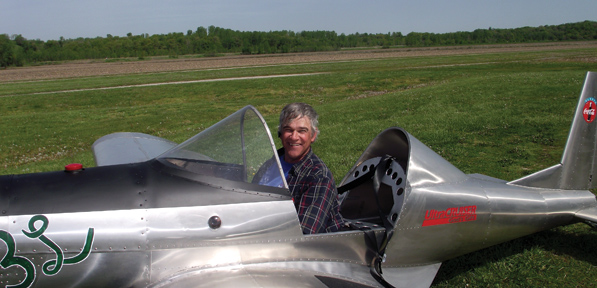
Brooks poses with his pride and joy.
One of the greatest assets of Liberty Landing International Airport is location, location, location. We are in the middle of the Missouri River flood plain. That means no houses can be built around the field, so consequently we can’t get shut down by irritated neighbors complaining about the noise. The other side of the coin is that we do have to get ready to evacuate the field during the spring river surges as the snow up north melts. The Great Flood of ’93 flooded the airport to a depth of over 20 feet and lasted for more than a month.
In the afternoons when the sun is low over the bluffs northwest of the field, we sit in our lawn chairs in the shade of the hangar, facing the road. If a plane does a fly-by down the runway, we always hurry to the other end of the hangar to see who it is, what it is, and hope for a landing for the Landing Judges to evaluate.
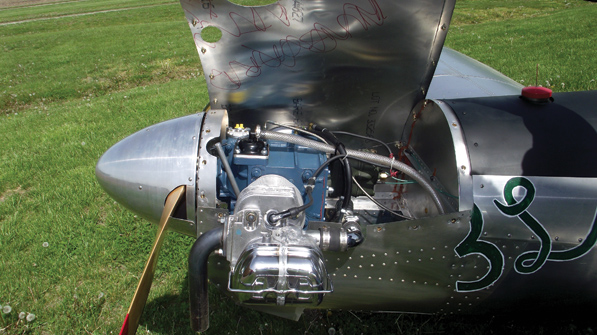
The Hummel half-VW is a little jewel. It starts easily and runs great. The engine installation is a thing of beauty.
As we sat there we noticed a car approaching from the southwest. Now, as sparse as the traffic is on our road, this was an event. If the car is not known to us, it might just be some FAA guy driving around looking things over. We are all squeaky-clean legal-wise when it comes to the FAA, but you and I know that some of these guys have an agenda and love violating pilots and planes. Knowing that the FAA is on the field is always a high-pucker event.
This time as the car morphed into a van, we settled back in our chairs and watched its approach with interest. The nondescript van was towing an aircraft fuselage on a trailer.
The van pulled up in front of us, and the driver got out and introduced himself. He was Dennis Brooks of Independence, Missouri, just across the river.
No Vacancy
Brooks asked us a question that we hear all the time from drop-in visitors: “Is there any hangar space available here?”
The short answer is, “No.” As more and more small airports close down, hangar space is getting harder and harder to find. (And, if you do locate a hangar, the rents have gone way up.) The little field where I learned to fly, Mount Muncie Airport near Lansing, Kansas, just shut its doors last month after more than 50 years. The aircraft owners were, with no warning, given 30 days to vacate with their planes, tools and other equipment. Two of the guys displaced are Dawn Patrol members. If your plane is a cloth-covered WW-I replica, tying it down outside in Missouri is a sure-fire invitation to a disaster. A Missouri “big black surly” summer thunderstorm with hail and high winds will instantly “re-kit” any lightweight homebuilt aircraft. A hangar is an absolute must. (Just today a BBS passed to the north of the field with 60-mph gusts and tennis-ball-size hail. Either one of those two factors would have been death to a small, lightweight, fabric-covered aircraft tied down outside.)
So the great hangar search started for our two WW-I fliers. Both owners found space available at an airport only about 30 miles away where they could store their planes temporarily while they tried to locate a more permanent place closer to home.
Some discouraged pilots eventually give up and sell their planes rather than tie them down in the open, just waiting for Mother Nature to roll them up into little bitty balls of aluminum and badly torn fabric.
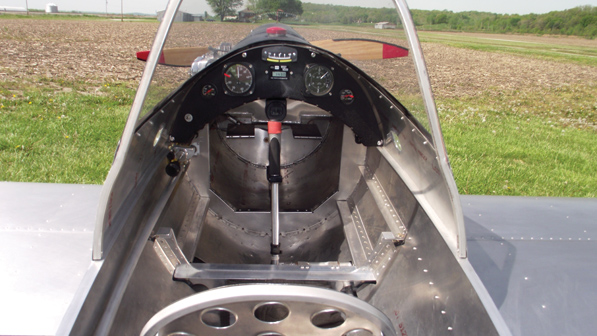
The workmanship on this build is impeccable. Lots of love went into this plane.
No Room at the Field
We sadly told Brooks the bad news. We were sad, too. This little jewel looked like a real Liberty Landing aircraft. But Liberty Landing International has a long waiting list for hangars, just like all of the airports around us.
As we looked over the plane, we realized we were looking at a labor of love. Brooks had built it “scratch” from plans. It was a Hummel UltraCruiser that he’d finished in only five months and 11 days. He’d made all the forms and patterns himself. He said the two hardest things he had to do were getting the bulkheads lined up on the building beam, and remembering to stop working on it and go to bed! It really showed, too. His workmanship was fantastic. He had about $11,000 in the whole aircraft.
The engine is a half-VW from Hummel Engines. The engine puts out 37 horsepower and swings a 54×22 prop.
Hearing that there wasn’t any hangar space didn’t seem to really break Brooks’s heart. The reason is that his UltraCruiser is a reasonably trailer-friendly aircraft. Right out of the box, he can get it from road-ready to flight-ready in a little less than 40 minutes. That’s not bad. I’m betting as time passes, he’ll be able to build some fixtures and jigs to make the assembly/disassembly process easier.
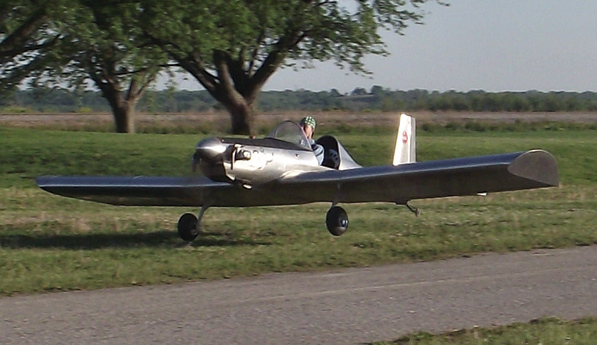
Greasing the UltraCruiser in for a landing. Pretty good crosswind from the right, too. Check out the rudder and ailerons.
He asked if he could do some taxi-testing on the field. “Sure,” we responded. “Let’s put that little sucker together!”
The UltraCruiser’s wings fit easily in the back of Brooks’s van. Unloading the fuselage and wings and laying them out for assembly took about 5 minutes. With our willing help, we probably added about 15 minutes to the assembly time.
As we had more and more time to examine the workmanship on his little masterpiece, we realized we were looking at the meticulous work of a master builder. This plane was just plain splendiferous! (to quote Mark Twain). As hard as we looked, we couldn’t find one thing to fault. The engine was a real piece of work, too. Brooks said that Terry Hallett and Mike Ingram at Hummel Aircraft were helpful with all questions and parts, as was Scott Casler of Hummel Engines.
When the plane was all assembled, we asked Brooks what it weighed. He wasn’t sure. Well…that was not a problem for The Dawn Patrol. We dug out our set of digital scales, fired up the laptop computers and in less than half an hour performed a weight and balance. HOLY LIGHTWEIGHT! It was a legal ultralight. What a deal.
The plane had only been taxi-tested so far. Just about then, who should drive up but Harvey Cleveland, our airport CFI, IA, A&P and movie star. (He flew my wife’s Morane in the opening scenes of the movie Amelia) and has more than 23,000 hours in all kinds of aircraft from ultralights to four-engine transports. He is also Robert Baslee’s chief test pilot. (Baslee is the owner of Airdrome Airplanes.)
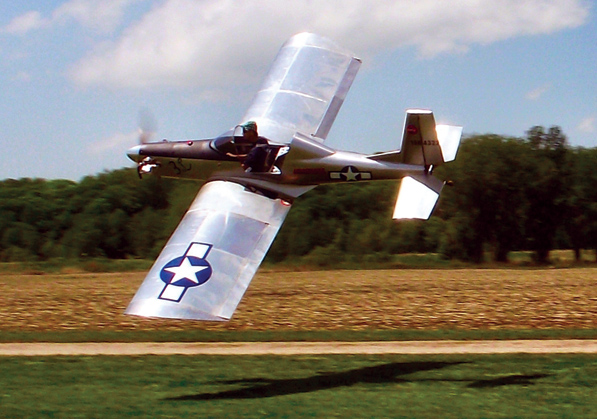
Harvey Cleveland makes a pass down the runway.
After checking the weight-and-balance figures, Cleveland carefully went over the plane and made some suggestions that we quickly carried out.
Anyway, Brooks asked Cleveland if he’d like to do some testing of the UltraCruiser. Five minutes later, after again reviewing the weight-and-balance figures and an extensive preflight, Cleveland was taxiing to the main (and only) runway at Liberty Landing International. After a few high-speed runs up and down the runway and a few “crow-hops,” he poured the coals to the plane and off they went. The next 10 minutes were an impressive demonstration.
Cleveland greased the landing and taxied over to us with a big smile on his face. The resulting squawk sheet conversation got us into high-speed modification mode. We removed the tailwheel springs and put some “500 mph” tape over the holes where the wings joined together. Then Cleveland blasted off again for another 10 minutes of yanking and banking. He landed with an even bigger smile on his face this time. By then, it was almost dark. We dismantled the plane, put it on the trailer, and Brooks left for home.
As Brooks and his UltraCruiser headed down the road, Tom Glaeser mumbled, “Do you think we could build four of those together?”
And so (shudder) the adventure continues.
Pilot Report
What follows is Cleveland’s evening email PIREP after both flights.
The temperature today was 80 F. One of the interesting discoveries today is that you can run out of left rudder on takeoff with a crosswind from the right. Full-throttle static thrust at 3220 rpm is 150 pounds. The major improvements were the elimination of the tailwheel springs and the addition of wing-root covers at the spar pins. Sealing up the gap between the center section and the wings nearly doubled the climb rate and reduced power requirements for all flight. Before, 3000 rpm was minimum level flight power. Now, it’s 2800 rpm. Before, 50 mph felt like minimum speed. Now, 40 feels fine. Climb rpm at 40 mph is 3300. Climb rpm at 50 mph is 3400. Level flight full throttle is 80 mph at 3700 rpm. I could make shallow constant altitude turns at 42 mph and felt like I still had a margin of safety. Now the only things I would do would be:
Remove non-sensitive altimeter.
Remove inop compass.
Remove inop skid ball.
Try to remove about 10 pounds from the nose to reduce nose heaviness.
Maybe remove instrument panel and move fuel tank back about a foot.
That would really make this plane rock.
Balance is everything when you are flying for fun.
It will greatly improve safety. Right now if the elevator controls failed, the plane would just lawn-dart into the ground.
Just barely tightening the taper pin nuts greatly improved their removal.
THIS PLANE IS A HOOT TO FLY.

